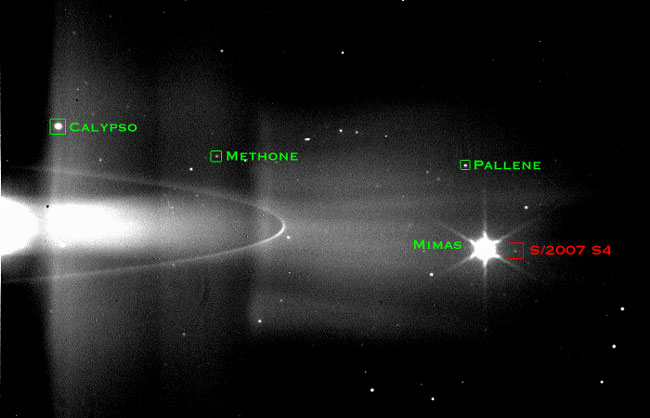New 60th Moon of Saturn Discovered

A new moon of Saturn has been discovered, bringing the planet's satellite tally to 60.
Initial measurements suggest the new moon, which is still unnamed, is about 1.2 miles (2 kilometers) wide, and lies between the orbits of Mehone and Pallene, two Saturnian moons discovered by NASA’s Cassini spacecraft in 2004. The newfound moon is about 1.09 million miles (1.76 million kilometers) from Saturn and could be part of a larger group of still undiscovered moons around the ringed planet.
The moon was observed by Cassini on May 30, 2007.
Saturn has the second largest tally of moons in the solar system next to Jupiter, which has 63. However, like the definition of “planet,” there is an ongoing debate about what size a satellite must be and how it must behave to qualify as a moon. If very small and as-yet unfound objects are ultimately included, the moon tallies could soar into the hundreds or even thousands.
- Moon of Saturn Sprays Cosmic Graffiti
- IMAGE GALLERY: Cassini’s Latest Discoveries
- IMAGE GALLERY: Snapshots of Saturn
Breaking space news, the latest updates on rocket launches, skywatching events and more!

Space.com is the premier source of space exploration, innovation and astronomy news, chronicling (and celebrating) humanity's ongoing expansion across the final frontier. Originally founded in 1999, Space.com is, and always has been, the passion of writers and editors who are space fans and also trained journalists. Our current news team consists of Editor-in-Chief Tariq Malik; Editor Hanneke Weitering, Senior Space Writer Mike Wall; Senior Writer Meghan Bartels; Senior Writer Chelsea Gohd, Senior Writer Tereza Pultarova and Staff Writer Alexander Cox, focusing on e-commerce. Senior Producer Steve Spaleta oversees our space videos, with Diana Whitcroft as our Social Media Editor.
